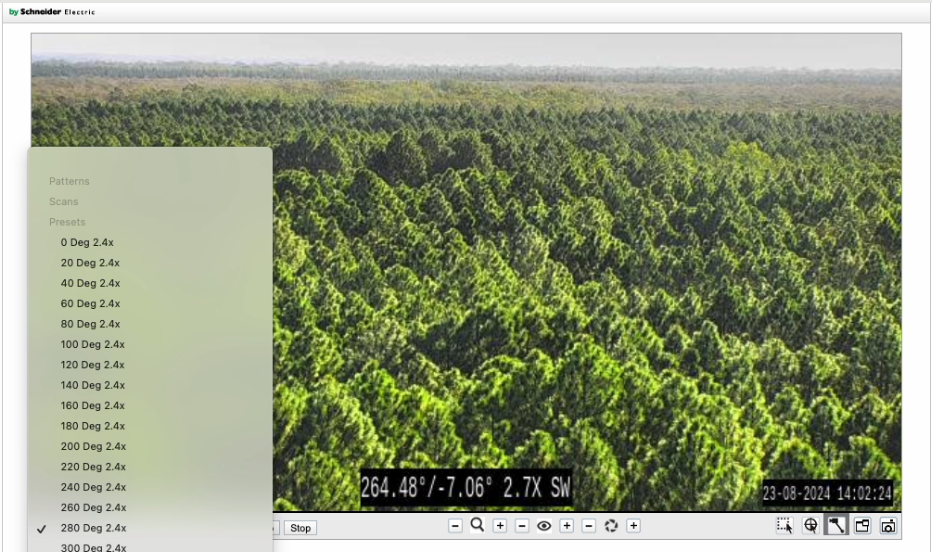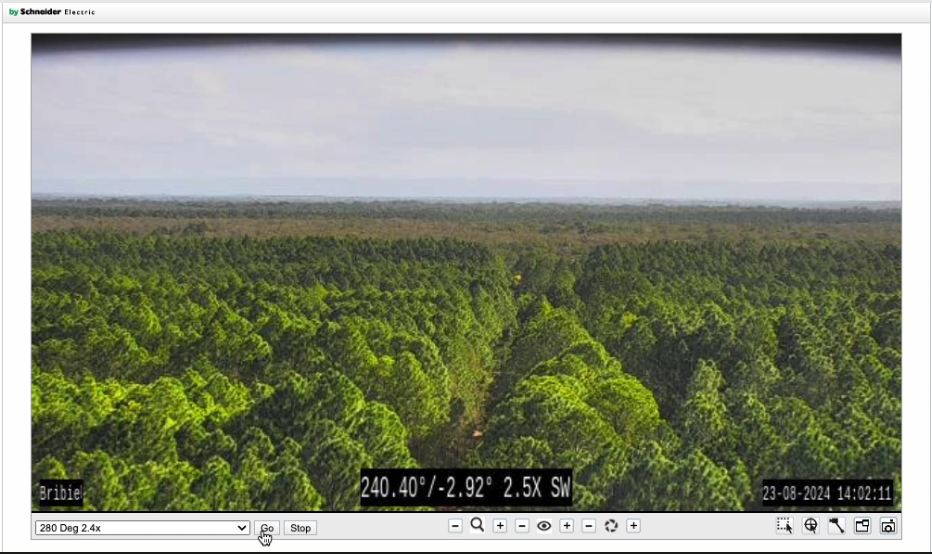exci is redefining wildfire detection with our cutting-edge, camera-agnostic AI-driven wildfire/bushfire detection technology. Our system integrates effortlessly with various types of cameras. This flexibility gives our customers unparalleled control over their surveillance setups, allowing them to optimise both coverage and performance according to their specific needs.
Our advanced AI examines camera images to detect fires at their earliest stages. When a fire is identified, customers receive instant access to camera live feeds, enabling real-time assessment and swift decision-making. This immediate access is crucial for effective fire management, supporting quick responses and initial attack efforts.
With exci’s system, users gain flexible camera integration, enhanced control, and real-time situational awareness. This approach ensures precise and responsive wildfire detection tailored to operational requirements.
In this blog post, we’ll dive into the technical aspects of our camera-agnostic AI technology, explore the challenges of using PTZ cameras for panoramic views, and explain how our No-Double-Dipping Policy fosters fairness and collaboration in wildfire detection.
exci’s Camera-Agnostic AI: High-Accuracy Wildfire Detection with Any Camera
exci’s AI-powered wildfire detection system is camera agnostic, enabling seamless integration with a wide range of cameras and ensuring high-accuracy fire detection regardless of brand, model, or specific capabilities.”
Customer Control: Customers can choose the cameras that best suit their needs, position them strategically, and use them based on specific requirements.
Access to Camera Feeds: Once our AI detects a fire, customers can immediately access the camera feed to assess the situation in real-time. This direct access enables quicker decision-making, allowing rapid response and initial attack procedures.
Challenges of Using PTZ Cameras for Panoramic Views
Creating panoramic views with PTZ (Pan-Tilt-Zoom) cameras, which can rotate 360 degrees, is technically feasible by stitching together the resulting images using Python libraries. However, this approach presents several significant challenges:
Disruption of Image Capture: Controlling the camera to pan, tilt, or zoom during the capture process can disrupt the sequence of images needed for stitching. These interruptions can lead to incomplete or misaligned panoramic images, undermining the quality and accuracy of the final output.
Incomplete or Inconsistent Panoramic Views: Changes in the camera’s position during rotation can cause visible seams, gaps, or inconsistencies in the final panoramic image. This can result in a less cohesive and unreliable view, especially when the camera is not perfectly aligned throughout the capture process.
Delayed Fire Detection: Interruptions in image capture may cause the AI to miss critical frames, leading to delays in fire detection. Such delays could have serious consequences in applications where real-time monitoring is crucial.
Customer Experience Issues: Manual intervention or inconsistent camera movements can make the PTZ camera behave unpredictably, hindering its ability to provide accurate real-time assessments and negatively impacting the user experience and trust in the system.
High Data Volume and Bandwidth Requirements: Stitching together high-resolution images generates substantial data, requiring significant bandwidth for transmission. This can introduce latency, particularly in remote or bandwidth-limited areas, where the system’s responsiveness is essential.
Power and Infrastructure Requirements: PTZ cameras demand robust hardware for continuous rotation and high-resolution data capture. Deploying such systems in areas with limited power resources increases costs and complexity. Ensuring a reliable power supply is critical to maintaining uninterrupted camera operations.
Processing Demands: Stitching high-resolution images into a seamless panorama requires significant computational power. Inadequate local processing capabilities can lead to delays, potentially impacting the system’s ability to detect fires promptly.
Data Stream Management: Managing continuous data streams from rotating PTZ cameras is complex. The system must handle multiple high-resolution image streams and synchronise them accurately, adding to the overall processing and network load.
High-Precision Image Stitching Tools
To overcome these challenges, several free and open-source image stitching tools and Python libraries can be employed for high-precision panoramic imaging:
OpenCV (Open Source Computer Vision Library): A powerful library for computer vision tasks, including image stitching. OpenCV offers robust algorithms for aligning and stitching images with high precision, making it a popular choice for creating panoramas.
Scikit-Image: A Python library that provides a collection of algorithms for image processing, including feature detection and image transformation, which are essential for high-quality stitching.
PanoStitcher: This Python library is specifically designed for panoramic image stitching. It provides tools for feature detection, image registration, and blending, making it easier to create seamless panoramas.
Hugin: A user-friendly open-source tool for creating panoramas from multiple images. Hugin offers advanced features for image alignment and stitching, making it a versatile choice for both beginners and advanced users.
ImageJ/Fiji: These open-source image processing programs come with plugins for stitching and analysing images, including a panorama plugin, making them suitable for various stitching needs.
These tools offer varying levels of precision and functionality, catering to different stitching requirements based on the complexity of the images and the level of control desired. However, stitching images together using Python libraries like OpenCV is generally straightforward for programmers with basic Python and image-processing skills.
UHD Cameras vs Standard Cameras for Wildfire Detection
Why Standard Cameras Are Better
When it comes to effective wildfire detection, ultra-high-resolution (UHD) cameras are not a necessity. exci’s advanced AI-powered technology demonstrates that standard cameras can achieve outstanding results without the added expense of UHD technology. So, what are the advantages and disadvantages of using UHD cameras compared to standard cameras for bushfire detection?
Resolution
- UHD Cameras offer much higher resolution, typically 4K (3840 x 2160 pixels) or higher. This provides more detailed images and allows for greater zooming capabilities without losing clarity.
- Standard Cameras generally offer lower resolutions, such as HD (1920 x 1080 pixels) or lower. While they provide adequate detail for many applications, they may not capture as much detail as UHD cameras.
Data Volume
- UHD Cameras produce significantly larger image files due to higher resolution. This increased data volume requires more storage space and higher bandwidth for transmission.
- Standard Cameras generate smaller image files, making them less demanding in storage and bandwidth.
Bandwidth and Connectivity
- UHD Cameras require high-speed internet connections, such as 5G or fibre optics, to handle the large amount of data they produce. This can be a limitation in areas with poor connectivity.
- Standard Cameras demand less bandwidth, which makes them more suitable for areas with limited or unstable internet connections.
Storage Requirements
- UHD Cameras need substantial storage capacity to handle the large volume of high-resolution video footage. This can increase the overall cost and complexity of the storage solution.
- Standard Cameras require less storage, making them more cost-effective and easier to manage.
Processing Power
- UHD Cameras demand higher processing power to handle and analyse large data files. This can strain local processing capabilities and may require more advanced hardware.
- Standard Cameras require less processing power, making them easier to integrate into existing systems and more efficient to manage.
Cost
- UHD cameras are generally more expensive due to their advanced technology and higher resolution capabilities. The additional costs extend to storage, processing, and data transmission.
- Standard Cameras are typically more affordable, with lower acquisition, storage, and data management costs.
Field of View and Detail
- UHD Cameras can provide a more detailed field of view, which is beneficial for applications requiring high levels of detail, such as detailed surveillance or scientific research.
- Standard Cameras offer adequate detail for general surveillance and monitoring but may lack the fine details UHD cameras provide.
Deployment Complexity
- UHD Cameras may require more sophisticated infrastructure to support their high data demands, including robust network solutions and advanced storage systems.
- Standard cameras are generally simpler to deploy and manage and have fewer infrastructure requirements.
In summary, while UHD cameras offer superior resolution and detail, they also increase data volume, cost, and infrastructure demands.
In contrast, standard cameras provide sufficient resolution and are far more cost-effective and easier to deploy for effective bushfire detection. By opting for standard cameras, exci delivers a practical, budget-friendly solution that ensures reliable AI-driven wildfire detection without the added complexities and expenses of UHD technology.
Why Direct Camera Control Matters
Panoramic images provide a broad view but lack real-time situational awareness due to the time needed to produce them. By the time they are available, they are often outdated, reducing their effectiveness in dynamic fire situations.
exci’s system, on the other hand, gives customers full control over the cameras, enabling real-time movement and zooming capabilities for precise fire assessment. This ensures live streaming access with an essential temporal element, providing immediate and accurate situational awareness critical for effective fire management.
 exci’s system allows Real-time Camera Access for Fire Assessment
exci’s system allows Real-time Camera Access for Fire Assessment
Techquity and exci: Revolutionising Safety with Cutting Edge Technology
We are excited to present our ultimate solution for wildfire detection and environmental monitoring: a cutting-edge, remote-deployable system that combines advanced cameras, communication technology, and weather monitoring to detect bushfires in their earliest stages. This innovative, self-contained unit is engineered for rugged, off-grid locations and is powered by top-tier components to ensure uninterrupted operation.
Developed by exci, Techquity’s system leverages edge-based artificial intelligence to deliver real-time situational awareness, detecting smoke signals indicative of bushfires with unmatched precision directly from the camera.
Featuring multiple high-resolution cameras and advanced sensors, the system provides instant alerts, enabling swift responses to new ignitions and aiding in keeping bushfires under control. It also enhances situational awareness for Incident Controllers and Management Teams, ensuring the safety of both aviation and frontline personnel.
 Remote deployable camera, communications and weather monitoring system powered by exci’s AI advanced technology
Remote deployable camera, communications and weather monitoring system powered by exci’s AI advanced technology
Key Features:
- AI Edge Analytics: exci’s cutting-edge AI operates directly at the edge, enabling rapid fire detection and swift response to minimise potential damage.
- 360-Degree Coverage with Dual 180-Degree Cameras: Two 180-degree cameras provide a full 360-degree view, covering the East and West cardinal directions to ensure comprehensive monitoring and capture of potential fire threats from any direction.
- High-Resolution PTZ Camera: Delivers sharp, detailed close-ups for precise monitoring, empowering quick and informed decision-making in critical situations.
Versatile Applications:
- Planned burning operations
- Early bushfire detection
- Post-lightning landscape analysis
- Incident management
- ASB-D flight monitoring
- And much more!
With an integrated LoRa gateway, this system offers wide-area coverage and seamless communication. It connects to an extensive network of sensors with a range of over 40 km, making it ideal for protecting critical landscapes, wildlife habitats, and natural resources.
exci’s No-Double-Dipping Policy: Fair Wildfire Detection
At exci, we are committed to fairness and collaboration with our No-Double-Dipping Policy.
What does this mean? Suppose a customer, such as a forestry owner, wants to share their bushfire detection notifications with neighbouring forestry covered by their cameras. In that case, we do not charge the neighbouring entity for the same service. This policy ensures fair access and supports collaborative efforts in wildfire detection and prevention, allowing the neighbouring forestry to receive alerts without incurring additional costs.
Typically, managing access to the same camera feed for multiple users from different customers would present technical and logistical challenges, including:
- Access Conflicts: Concurrent access requests could lead to conflicts or delays.
- Technical Limitations: Systems might struggle with simultaneous access if not designed for it.
- Data Privacy and Security: Shared access complicates privacy and security management.
However, exci has developed an effective solution that allows multiple users from different customers to access cameras seamlessly, overcoming these challenges and ensuring efficient and secure operations.

Summary
exci is committed to empowering our customers by providing direct access to camera feeds, crucial for effective fire assessment and response. Our camera-agnostic approach ensures that our AI-powered wildfire detection system can integrate with various cameras. It offers flexibility and allows customers to choose the best camera solutions for their needs. Key points include:
No Double Dipping Policy: Ensures fair access and supports collaborative bushfire/wildfire detection and prevention efforts
Cost-Effective Standard Cameras: Achieves accurate wildfire detection without the need for expensive UHD cameras.
Real-time Camera Access: Empowers customers with real-time access to camera feeds for effective bushfire assessment and response.
exci’s solutions are designed to deliver reliable wildfire detection and support collaborative efforts, ensuring an effective and practical approach to managing wildfire risks.
by Gabrielle Tylor
exci – Smoke Alarm for the Bush
AI-powered Wildfire/Bushfire Detection Technology
3 September 2024

